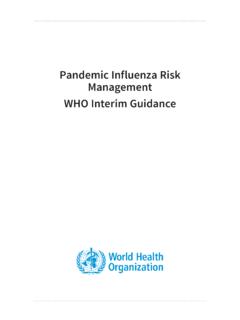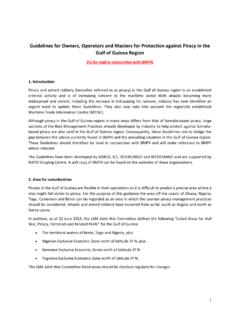Transcription of Trichloroethylene (TCE) Indoor Air Guidance to …
1 Trichloroethylene (TCE) Indoor Air Guidance to Protect Building Occupants from Developmental Risk A Joint Guidance from the connecticut Departments of Public Health (DPH) and Energy and Environmental Protection (DEEP) February 2015 The TCE Target Indoor Air Concentration (TAC) used to calculate RSR volatilization criteria is 5 g/m3 for both the residential and industrial/commercial scenarios. This target was set in the 1996 RSR criteria based upon cancer risk with adjustment for the amount of TCE that can occur in background Indoor locations. An important new development is that animal and human studies have shown TCE to be a developmental toxicant, causing cardiac defects and impaired immunity from in utero exposure.
2 Both animal and human epidemiology studies provide evidence of TCE s toxicity to fetal development (USEPA, 2011; Forand et al. 2012, Chiu et al. 2013). This has led USEPA to derive an inhalation reference concentration (RfC) of 2 g/m3 to protect against these developmental effects (USEPA, IRIS 2011). This document describes Guidance for residential and industrial/commercial sites in which TCE vapor intrusion may create an acute developmental risk. A supporting document provides additional background on TCE developmental toxicity (CTDPH, 2014). The time frame over which exceedance of the RfC may create a significant public health risk is much shorter than the cancer-based target.
3 While the time point during pregnancy that is sensitive to TCE is not well studied, it is likely less than the full gestation period and may be on the order of days to weeks. In fact, the USEPA Office of Solid Waste and Emergency Response (OSWER) has, in a compilation of information relevant to TCE developmental effects, indicated that even a single exposure may be sufficient to be of concern (Richardson, 2014). Therefore, DEEP and DPH understand the TCE RfC (2 g/m3) as a short-term exposure limit that is relevant to pregnant women and women of child-bearing age that are present in TCE-affected homes (24 hr/day, 7 day/wk exposure).
4 Regarding occupational settings, workers are assumed to be on the job for only 8 hr/day, 5 days/wk. This allows their exposure to rise to g/m3 and still meet the 2 g/m3 target on a time weight-averaged basis. This Indoor air target concentration is being used by the USEPA Region 9 Superfund office as the accelerated response action trigger for commercial/industrial buildings in which concentrations above 8 g/m3 require interim steps to rapidly mitigate exposure ( , sealing cracks, increased ventilation, Indoor air monitoring, air filtration devices) (Manzanilla 2014). Because of this DPH and DEEP recognize the need for the TCE volatilization criteria to have short-term TACs as follows: TCE residential short-term TAC1 5 g/m3 (1 Ideally the residential TAC should match USEPA s RfC of 2 g/m3 but since this is below the current RSR it is used as a goal.)
5 If a site is at 5 g/m3 in a residential setting the risk evaluator should realize this is already an elevated risk for TCE-induced developmental effects and place additional priority on this site.) TCE industrial/commercial short-term TAC 8 g/m3 These short-term TACs do not supersede the long-term TACs that are in the RSRs to prevent cancer risk. The implication of this new approach is that expedited follow-up is needed at sites where the short-term TAC may be exceeded based upon volatilization modeling or actual monitoring. Thus, expedited follow-up is needed at residential sites that have subsurface TCE contamination that equals or exceeds the RSR 1996 volatilization criteria (groundwater or soil vapor or both) or at industrial/commercial sites that are fold or more greater than the 1996 volatilization criteria.
6 Expedited follow-up that should be considered at these sites includes: 1) Remediation of the contamination and/or protection of the building from TCE intrusion with a subsurface depressurization system; 2) Given that option 1 may not occur as rapidly as would be ideal, then Indoor air testing should be conducted to assess the level of TCE in the home or workplace; 3) If the level of TCE in Indoor air is found to be above 5 (residential) or 8 (industrial/commercial) g/m3 in occupied spaces, then increased ventilation and other immediate options ( , sealing of cracks to prevent subsurface intrusion) should be considered to protect occupants in the short term while longer term solutions are being developed.
7 As noted above, the RfC is 2 g/m3. Residential TCE results above the RfC should be followed up with additional testing. Note: Indoor air testing is not needed to justify improved ventilation, but at a minimum Indoor air testing should be performed post ventilation changes to document that the levels do not exceed 5 g/m3 in residential or 8 g/m3 in occupational settings. The long-term remediation goal is to bring the TCE concentration below both the short-term and cancer risk-based TACs. This approach is in consideration of recent USEPA Region 9 (Manzanilla, 2014) and the State of Massachusetts (MassDEP 2014) Guidance on short-term air targets for expedited action at TCE infiltration sites.
8 In addition to using 8 g/m3 as a target for expedited action, USEPA Region 9 and Massachusetts have set 24 g/m3 as the commercial/industrial trigger for more urgent action (USEPA, July 2014; Mass DEP, 2014). This can include notification and relocation of employees in addition to the immediate mitigation measures described above. For residential settings, USEPA Region 9 has an immediate occupant notification level for women of childbearing age of 6 g/m3 which is similar to the current RSR TAC of 5 g/m3. While the current DEEP/DPH Guidance does not set immediate notification levels for workers or residents, those sites over 24 g/m3 (I/C) or over 6 g/m3 (residential) should receive the highest priority for rapid mitigation.
9 Summary The need for expedited follow-up at TCE vapor intrusion sites make these sites a higher priority for follow-up, especially relative to those sites which have long timeframes to achieve RSR compliance, (such as Transfer Act sites post-2009 which upon entering the system would normally have 8 years to achieve complete remediation). An aggressive time frame (more aggressive than 8 years, for instance) is needed when the following conditions exist: 1) TCE contaminates soil gas or groundwater within 15 below a residential site at or above the 1996 volatilization criterion or times above this criterion for industrial/commercial sites; 2) A building exists above this contamination; and 3) The building is currently occupied with residents or workers that include women of childbearing age.
10 When these conditions exist, unless there is additional evidence that the pathway to the receptors in the overlying building is incomplete, DPH (Environmental and Occupational Health Assessment) should be notified so that DEEP and DPH can jointly work with the LEP to assess and manage risks in the short-term until a long-term solution is in place. References Chiu W. A. et al. 2013. Human health effects of Trichloroethylene . Key findings and scientific issues. Environ Health Perspectives 121: 303-311. CT DPH. 2014. Brief Review of Trichloroethylene (TCE) Developmental Risks. Forand et al. 2012. Adverse birth outcomes and maternal exposure to Trichloroethylene and tetrachloroethylene through soil vapor intrusion in New York State.













